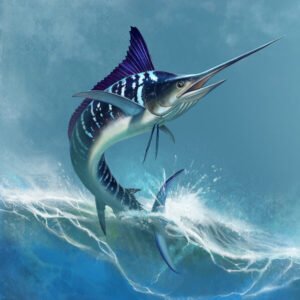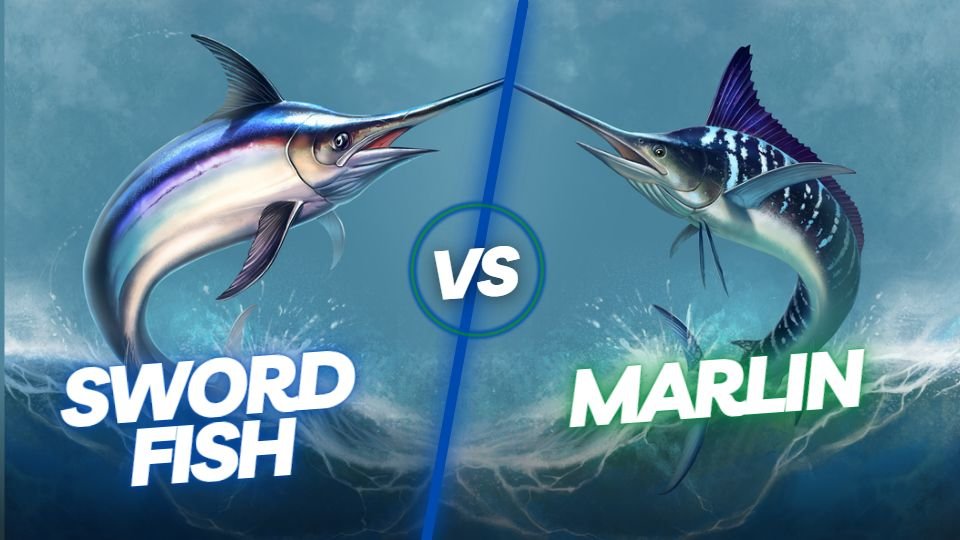What is the Difference Between Swordfish and Marlin?
Don’t be like my friend. He embarrassed himself at a dinner party because he had confused marlin with swordfish, a common misunderstanding due to their appearance. Still, they are different species but closely related, so I’ll write about the differences between a swordfish and a marlin in this article and clear up any confusion. Let’s begin.
Comparison Table
| Feature | Swordfish (Xiphias gladius) | Marlin (Istiophoridae) |
|---|---|---|
 |  | |
| Body shape | Elongated and Round | Cylindrical and Long |
| Lives in | Atlantic, Pacific and Indian Oceans | Atlantic, Pacific and Indian Oceans |
| Normal habitat | Tropical waters of depth 0-550 m or 1800 ft | Tropical waters of depth 0-100 m or 0-330 ft |
| Max depth | 2,878 m or 9,442 ft | 472 m or 1549 ft |
| Normal length | 3 m or 10 ft | 3.4 m or 11 ft |
| Max length | 4.55 m or 14 ft 11 in | 5 m or 16 ft |
| Normal weight | 23-90 kg or 50-200 pounds | 90-180 kg or 200-400 lb |
| Max weight | 650 kg or 1,430 lb | 820 kg or 1,810 lb |
| Maturity | 4-5 years | 2-4 years |
| Lifespan | 9 years | 10 years |
| Max lifespan | 16 years | 20 years |
| Diet and prey | mackerel, silver hake, barracudinas, herring, rockfish, laternfish, demersal fish, crusaceans, squid and more. | pelagic fish, tunas, dolphins, mackerels, flyingfish and more. |
| Conservation status | Least Concern | Vulnerable (White and Blue Marlin) |
Physical Characteristics: Swordfish vs Marlin
First, we’ll look at the most apparent similarities and key differences between these two fish: their appearance. How to tell the difference when they both have sword-like bills? Swordfish are typically quite large and have a long, sleek shape. They are darkly colored, usually varying from deep blue to brown hues. Additionally, they have a unique fin and tail configuration, which helps them cut through the water with speed and agility.
On the other hand, Marlin is also quite large and has a long, pointed shape. Depending on the species, their coloration can vary from deep blues to bright greens, but they still maintain their unique fin and tail configuration, which helps them swim powerfully through the water. The comparison between Swordfish and Marlin lies in their size and fin shapes; both are quite large and share a unique fin shape though swordfish are sleeker while Marlin has more of a pointed shape. Color-wise, swordfish tend to be dark. Marlin can vary more in color depending on the species, as there are many types of marlin: striped marlin, Atlantic and Pacific blue marlin, black marlin, etc.
Main Differences Between Marlin vs Swordfish Habitat and Distribution
These two fish species inhabit the world’s oceans, but they have distinct differences in their habitats and distributions. Swordfish prefer temperate waters, while Marlin prefer warmer waters, which means that swordfish can be found in regions such as the North Atlantic Ocean and the Mediterranean Sea and dive deeper than 500 meters.
In comparison, Marlin often lives in areas like the Caribbean Sea and The Gulf of Mexico and only dives to around 100 meters. Swordfish migrate more frequently and further across entire ocean basins to find suitable temperatures, whereas Marlin tends to stay within a specific region for most of their lives.
Furthermore, the range and distribution of both species vary; some species may be more abundant in certain areas than others due to environmental or seasonal changes. Overall, understanding the differences between these two species habitats and distributions can give us an insight into how they interact with their environment.
Difference Between Marlin and Swordfish Behavior and Feeding Habits
The difference between Marlin and Swordfish behavior and feeding habits are distinct. Swordfish use a different hunting technique than Marlin, called surface feeding, where they swim vertically to the surface of the water to catch prey. Meanwhile, Marlin uses a method called “bill-swiping,” which uses its bill to stun the target before consuming them.
Both species prey on different types of fish and squids but maintain unique behaviors. For example, swordfish tend to leap out of the water in pursuit of their prey, while Marlin can swim very quickly for short bursts of speed when chasing after their food. Feeding habits also vary throughout their life cycle, with juvenile Marlin mostly eating crustaceans like shrimp. In contrast, an adult Marlin typically consumes large fish such as tuna or mackerel. Similarly, younger swordfish will feed on smaller fish such as herring or anchovies, whereas an adult Swordfish would predominantly eat squids and bigger fish like bonito or mackerel.
Scientific Classification
Marlin is closely related to the swordfish as they are part of the billfish family (Istiophoriformes). However, they are more closely related to spearfish and sailfish, the world’s fastest fish. If all marlin species are siblings, you can consider the swordfish their cousin, and they are alone as a single species in their family, as their other related “siblings” are extinct. Here’s a hierarchical view of the scientific classification and family tree of these billfish:
Istiophoriformes (Billfish order):
- Xiphiidae (Swordfish family)
- Swordfish (Xiphias gladius)
- Istiophoridae (Marlin family)
- Istiompax (Black marlin)
- Black marlin (Istiompax indica)
- Istiophorus (Sailfish)
- Atlantic sailfish (Istiophorus albicans)
- Indo-Pacific sailfish (Istiophorus platypterus)
- Makaira (Blue marlin)
- Atlantic blue marlin (Makaira nigricans)
- Indo-Pacific blue marlin (Makaira mazara)
- Kajikia
- White marlin (Kajikia albida)
- Striped marlin (Kajikia audax)
- Tetrapturus (Spearfish)
- Shortbill spearfish (Tetrapturus angustirostris)
- Mediterranean spearfish (Tetrapturus belone)
- Roundscale spearfish (Tetrapturus georgii)
- Longbill spearfish (Tetrapturus pfluegeri)
- Istiompax (Black marlin)
Difference Between Marlin vs Swordfish Economic and Ecological Importance
Both species of fish are commercially and sport-fished. Swordfish are classified as “least concern,” but since 2011, blue and white marlin have been classified as “vulnerable.”
The impacts of fishing on the populations of these two species vary considerably. Ecologically, both species have an essential role in their ecosystem. Swordfish feed on schooling fish and prey on smaller sharks, while Marlin feeds on squid and baitfish. Both also form a more extensive food chain that helps maintain balance in marine environments. The presence of these two species is essential for healthy ocean ecosystems as they help control predation levels and contribute to biodiversity.
Conclusion: Swordfish and Marlin Summary
Here is a summary of their differences and similarities:
- Physical Appearance:
- Swordfish:
- Large size
- Long and sleek shape
- Dark coloration
- Unique fin and tail configuration
- Marlin:
- Large size
- Long and pointed shape
- Varies in coloration
- Distinctive fin and tail configuration
- Comparison:
- Both are large and have unique fin shapes
- Swordfish is sleeker; Marlin has a pointed shape
- Swordfish is dark; Marlin varies in color
- Swordfish:
- Habitat and Distribution:
- Swordfish and Marlin found in different oceanic regions
- Swordfish prefer temperate waters, and Marlin warmer
- Swordfish migrate more, and Marlin stay in specific regions
- The range and distribution of both species vary
- Behavior and feeding habits:
- Swordfish uses a different hunting technique than Marlin
- Both are predatory fish and prey on different types of small fish and squids
- Unique behaviors observed in both species
- Feeding habits vary throughout the life cycle
- Economic and Ecologic Importance:
- Both are commercial and sport fish
- Swordfish is considered least concern, while marlin is considered vulnerable.
- Both species have an ecological role in the marine ecosystem
Frequently Asked Questions about Marlin or Swordfish
What are the main differences between swordfish and marlin?
The main difference between them lies in their appearance and habitat. Swordfish are sleeker and darker in color, can dive deeper, migrate wider and swim further into less temperate waters. Marlins have more vibrant hues of blue and green depending on the marlin sub-species, stay near the surface, and don’t migrate outside of tropical waters in specific regions of the oceans.
Are swordfish and marlin related?
Yes. Marlin and swordfish are closely related as billfish in the order Istiophoriformes, but swordfish is in the family Xiphiidae, and marlins share the Istiophoridae family with spearfish and sailfish species.
What do swordfish and marlin look like?
Swordfish are large, sleek, dark fish with large fins and tails. Marlins are also large fish, but pointed and vary in colors of blue, green, yellow, and silver depending on the species of marlin and may have vertical stripes along the body.
How do swordfish and marlin differ in terms of habitat and distribution?
Swordfish live in temperate and tropical waters and are highly migratory. They can dive deep, often up to 500 meters, and have been observed to dive as deep as 2,800+ meters. On the other hand, Marlins prefer the warmer tropical waters near the surface but can dive to 100-300 meters. They are migratory, but the geographical zones in their migratory pattern are more fixed and less comprehensive than swordfish.
Are swordfish and marlin both good to eat?
Both swordfish and marlin are good to eat; they are fatty fish, and their meat is considered oily and tasty.
What is the current status of swordfish and marlin populations?
Swordfish are stable and classified as “least concern,” whereas two species of marlin (blue and white marlins) are classified as vulnerable.
How can we help protect swordfish and marlin?
You can support sustainable fishing efforts, spread awareness and donate to organizations that work on research and conservation of fish.

